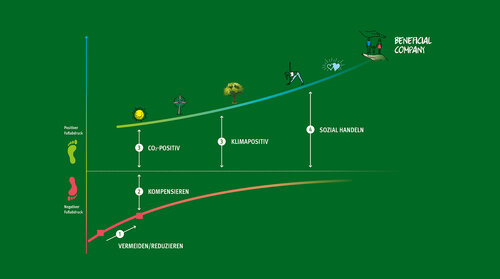"Environmental, Social, Governance" - ESG - stands for holistic business practice. This measures and evaluates the impact of economic activity on the environment, on human interaction and on corporate governance, over and above economic parameters. In this way, ESG minimizes future risks and creates incentives for long-term successful and therefore sustainable strategies. Drees & Sommer is guided by ESG regulations and supports clients in introducing and complying with them.
WHAT DOES ESG STAND FOR?
ESG stands for Environmental, Social (and Corporate) Governance. It refers to a business practice that, in addition to economic success, also strives to make improvements in these three areas. Compliance with ESG principles results in the creation of sustainability-oriented industrial and financial products.
Many regulations and instruments with specific criteria and indicators have been published in recent years that allow developments and progress in these three areas to be measured and compared. The aim is for the areas E, S and G to be seen as opportunities for creating a sustainable future so that entrepreneurial activity can be aligned accordingly. Until recently, companies have undertaken the systematic assessment of opportunities and risks based on such economic factors as their capital resources or market value. In the future, sustainability and ESG principles will also be crucial elements of such assessments.
600
pages
pages that is the size of the report by the Technical Expert Group (TEG) on the EU taxonomy.
85 %
of DAX companies
use the GRI Standards as a framework for their sustainability reports.
49.000
is the number of companies
to which the new EU Corporate Sustainability Reporting Directive (CSRD) will apply.
WHY IS ESG RELEVANT TO YOUR COMPANY?
- ncreasingly, sustainability criteria are seen as an entrepreneurial duty and not simply an option.
- Keyword ‘divestment’: Investors and stakeholders evaluate their investments according to ESG criteria. Fulfillment of these criteria offers opportunities today, whereas non-fulfillment represents a future financial risk.
- Your customers and business partners expect transparency and disclosure, added to which the demand for genuinely environmentally and socially responsible products is steadily increasing.
- Buildings and infrastructure have the largest ecological footprint. From an investor’s point of view, real estate, as a long-term asset class, is particularly exposed to the risk of high loss of value – with the risk of turning into stranded assets.
- Sustainable business models will dominate the market in the medium to long term, so a sustainability strategy with clear objectives will give you a decisive competitive edge.

WHAT ESG STRATEGY ARE YOU PURSUING?

Compliance-oriented
Numerous regulations, many of them complex and far-reaching, have emerged for different market players following the Paris Climate Agreement and Agenda 2030 (Sustainable Development Goals, SDGs). It is important to stay abreast of evolving sustainability systems to ensure that your business activity remains lawful and compliant in the future, and to meet the EU’s ESG criteria. It is also essential to manage sustainability risks and be in a position to act with suitable tools and strategies. We can support you in these areas.

Future-oriented
The sustainability megatrend requires adapted or completely new business models. But it also opens up huge opportunities. Our future-oriented consulting undertakes a 360-degree view with you and supports you on your way to becoming a successful sustainability pioneer – with measures ranging from a Quick Check to developing and implementing an appropriate strategy and reporting.
Whether you want to establish legally compliant reporting or to establish your company as a sustainable pioneer in your sector, we can offer a custom-fit solution.
Our solutions
WHICH SECTOR DOES YOUR COMPANY BELONG TO?
The following sectors of the EU taxonomy represent the economic activities that are responsible for 80 percent of carbon emissions under the classification system.
WHAT IS THE PATH TO 2050?
Where does Path 2050 lead? You can read here about currently applicable directives and regulations – and the requirements you will face in the future.

WHICH DIRECTIVES AND LEGISLATION APPLY TO YOU?
The following provides an overview of the key ESG regulations:
- EU taxonomy
- SFDR (Sustainable Finance Disclosure Regulation)
- NFRD (Non-Financial Reporting Directive)
The information provided here is limited to selected key aspects.
What is the EU taxonomy?
Who does it apply to?
When does it take effect?
How will it be implemented?
What is SFDR?
Who does it apply to?
When does it take effect?
How will it be implemented?
What is CSRD?
Who does it apply to?
When does it take effect?
How will it be implemented?












